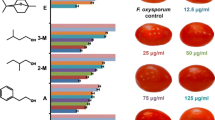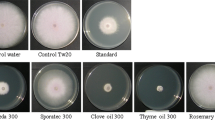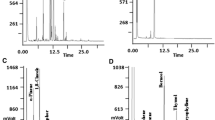Abstract
The effect of essential oils and individual monoterpenoids on soil-borne fungi, in pure and mixed cultures, in growth media and in the soil environment, was investigated. Essential oils were extracted from lavender (Lavandula stoechas), oregano (Origanum vulgare subsp. hirtum), sage (Salvia fruticosa) and spearmint (Mentha spicata). The monoterpenoids tested were fenchone, carvacrol, 1,8-cineole, carvone, α-pinene and terpinen-4-ol. Their effect was examined on growth and sporulation of Aspergillus terreus, Fusarium oxysporum, Penicillium expansum and Verticillium dahliae isolated from an organic cultivation of tomato. All tested essential oils and individual monoterpenoids inhibited mycelial growth in all fungi and conidial production in most fungi. The strongest inhibitory activity on mycelial growth was exhibited by oregano and spearmint oils and by carvacrol and carvone, respectively their main constituents. The inhibitory activity was clearly fungistatic in A. terreus and F. oxysporum but fungicidal in V. dahliae. On sporulation, clearly stimulatory effects were observed alongside inhibitory ones. Conidial production was always promoted by α-pinene in P. expansum and by sage oil in F. oxysporum. At certain dosages it was promoted by cineole and carvone in F. oxysporum, and by lavender oil in A. terreus and V. dahliae. Experiments with carvone and carvacrol against mixed fungal cultures in a soil environment showed that V. dahliae was the most sensitive and A. terreus the most tolerant of the four fungi. Our results demonstrate strong but divergent effects and selectivity of action of the lower terpenoids on fungal strains that can become serious pests of tomato. Of special importance is the complete inhibition of growth and conidial production of V. dahliae, a pathogen otherwise very resistant to chemical control.

Similar content being viewed by others
Abbreviations
- CDA:
-
Czapek dox agar
- CFU:
-
colony forming units
- RMGR:
-
recovery of mycelial growth
- WA:
-
water agar
References
Angioni, A., Barra, A., Coroneo, V., Dessi, S., & Cabras, P. (2006). Chemical composition, seasonal variability, and antifungal activity of Lavandula stoechas L. ssp. stoechas essential oils from stem/leaves and flowers. Journal of Agricultural and Food Chemistry, 54, 4364–4370.
Bång, U. (2007). Screening natural plant volatiles to control the potato (Solanum tuberosum) pathogens Helminthosporium solani, Fusarium solani, Phoma foveata, and Rhizoctonia solani. Potato Research, 50, 185–203.
Basílico, M. Z., & Basílico, J. C. (1999). Inhibitory effects of some spice essential oils on Aspergillus ochraceus NRRL 3174 growth and ochratoxin A production. Letters in Applied Microbiology, 29(4), 238–241.
Calvo, A. M., Wilson, R. A., Bok, J. W., & Keller, N. P. (2002). Relationship between secondary metabolism and fungal development. Microbiology and Molecular Biology Reviews, 66, 447–459.
Chalkos, D., Kadoglidou, K., Karamanoli, K., Fotiou, C., Pavlatou-Ve, A. S., Eleftherohorinos, I. G., et al. (2010). Mentha spicata and Salvia fruticosa composts as soil amendments in tomato cultivation. Plant and Soil, 332, 495–509.
Daferera, D. J., Ziogas, B. N., & Polissiou, M. G. (2000). GC-MS analysis of essential oils from some Greek aromatic plants and their fungitoxicity on Penicillium digitatum. Journal of Agricultural and Food Chemistry, 48, 2576–2581.
Daferera, D. J., Ziogas, B. N., & Polissiou, M. G. (2003). The effectiveness of plant essential oils on the growth of Botrytis cinerea, Fusarium sp. and Clavibacter michiganensis subsp. michiganensis. Crop Protection, 22, 39–44.
Farag, R. S., Daw, Z. Y., & Abo-Raya, S. H. (1989). Influence of some spice essential oils on Aspergillus parasiticus growth and production of alfatoxins in a synthetic medium. Journal of Food Science, 54, 74–76.
Goud, J. C., Termorshuizen, A. J., & Gams, W. (2003). Morphology of Verticillium dahliae and V. tricorpus on semi-selective media used for the detection of V. dahliae in soil. Mycological Research, 107, 822–830.
Hall, T. A. (1999). BioEdit: a user-friendly biological sequence alignment editor and analysis. Nucleic Acids Symposium Series, 4, 95–98.
Hountondji, F. C. C., Hanna, R., & Sabelis, M. W. (2006). Does methyl salicylate, a component of herbivore-induced plant odour, promote sporulation of the mite-pathogenic fungus Neozygites tanajoae? Experimental and Applied Acarology, 39, 63–74.
Kalemba, D., & Kunicka, A. (2003). Antibacterial and antifungal properties of essential oils. Current Medicinal Chemistry, 10, 813–829.
Karamanoli, K., Vokou, D., Menkissoglu, O., & Constantinidou, H.-I. (2000). Bacterial colonization of phyllosphere of Mediterranean aromatic plants. Journal of Chemical Ecology, 26, 2035–2048.
Karamanoli, K., Kadoglidou, K., Tananaki, C., Thrasyvoulou, A., Constantinidou, H.-I. A., & Vokou, D. (2008). Transformations of Mentha spicata essential oil in the soil environment. Planta Medica, 74, 1201.
Karousou, R., Vokou, D., & Kokkini, S. (1998). Variation of Salvia fruticosa essential oils on the island of Crete (Greece). Botanica Acta, 111, 250–254.
Khaddor, M., Lamarti, A., Tantaoui-Elaraki, A., Ezziyyani, M., Castillo, M. E. C., & Badoc, A. (2006). Antifungal activity of three essential oils on growth and toxigenesis of Penicillium aurantiogriseum and Penicillium viridicatum. Journal of Essential Oil Research, 18, 586–589.
Kim, Y. K., & Xiao, C. L. (2010). Influence of environmental factors on conidial germination and survival of Sphaeropsis pyriputrescens. European Journal of Plant Pathology, 126, 153–163.
Kokkini, S., & Vokou, D. (1989). Mentha spicata (Lamiaceae) chemotypes grown wild in Greece. Economic Botany, 43, 192–202.
Kuate, J., Foko, J., Ndindeng, S. A., Jazet-Dongmo, P. M., Fouré, E., Damesse, F., et al. (2006). Effect of essential oils from citrus varieties on in vitro growth and sporulation of Phaeoramularia angolensis causing citrus leaf and fruit spot disease. European Journal of Plant Pathology, 161, 114–151.
Larkin, M. A., Blackshields, G., Brown, N. P., Chenna, R., McGettigan, P. A., McWilliam, H., et al. (2007). Clustal W and Clustal X version 2.0. Bioinformatics, 2, 2947–2948.
Müller-Riebau, F., Berger, B., & Yegen, O. (1995). Chemical composition and fungitoxic properties to phytopathogenic fungi of essential oils of selected aromatic plants growing wild in Turkey. Journal of Agricultural and Food Chemistry, 43, 2262–2266.
Olanya, O. M., & Larkin, R. P. (2006). Efficacy of essential oils and biopesticides on Phytopthora infestans suppression in laboratory and growth chamber studies. Biocontrol Science and Technology, 16(9), 901–917.
Pawar, V. C., & Thaker, V. S. (2007). Evaluation of the anti-Fusarium oxysporum f. sp cicer and anti-Alternaria porri effects of some essential oils. World Journal of Microbiology and Biotechnology, 23, 1099–1109.
Pitarokili, D., Tzakou, O., Loukis, A., & Harvala, C. (2003). Volatile metabolites from Salvia fruticosa as antifungal agents in soilborne pathogens. Journal of Agricultural and Food Chemistry, 51, 3294–3301.
Pradhanag, P. M., Momol, M. T., Olson, S. M., & Jones, J. B. (2003). Effects of plant essential oils on Ralstonia solanacearum population density and bacterial wilt incidence in tomato. Plant Disease, 87, 423–427.
Rahmani, M., Ling, C. Y., Meon, S., Ismail, H. B. M., & Sucari, M. A. (2004). The antifungal activity of Glycosmis calcicola and G. rupestris extracts. Pharmaceutical Biology, 42, 430–433.
Soković, M., & Van Griensven, L. J. L. D. (2006). Antimicrobial activity of essential oils and their components against the three major pathogens of the cultivated button mushroom, Agaricus bisporus. European Journal of Plant Pathology, 116, 211–224.
Thompson, D. P. (1989). Fungitoxic activity of essential oil components on food storage fungi. Mycologia, 81, 151–153.
Thompson, J. D., Gibson, T. J., Plewniak, F., Jeanmougin, F., & Higgins, D. G. (1997). The ClustalX windows interface: flexible strategies for multiple sequence alignment aided by quality analysis tools. Nucleic Acids Research, 24, 4876–4882.
Toothaker, L. (1993). Multiple comparison procedures. Newbury Park: Sage.
Vokou, D. (1999). Essential oils as allelochemicals: Research advances in Greece. In S. S. Narwal (Ed.), Allelopathy update: Basic and applied aspects (pp. 47–63). Enfield: Science.
Vokou, D., & Margaris, N. S. (1986). Autoallelopathy of Thymus capitatus. Acta Oecologica Oecol. Plant, 7, 157–163.
Vokou, D., Kokkini, S., & Bessière, J. M. (1993). Geographic variation of Greek oregano (Origanum vulgare subsp. hirtum) essential oils. Biochemical Systematic. Ecology, 21, 287–295.
Vokou, D., Chalkos, D., Yangou, M., & Karamanlidou, G. (2002). Activation of soil respiration and shift of the microbial population balance in soil as a response to Lavandula stoechas essential oil. Journal of Chemical Ecology, 28, 755–768.
White, T. J., Bruns, T., Lee, S., & Taylor, J. (1990). Amplification and direct sequencing of fungal ribosomal RNA genes for phylogenetics. In M. A. Innis, D. H. Gelfaund, J. J. Sninsky, & T. J. White (Eds.), PCR protocols: A guide to methods and applications (pp. 315–322). San Diego: Academic.
Zhang, Z., Schwartz, S., Wagner, L., & Miller, W. (2000). A greedy algorithm for aligning DNA sequences. Computational Biology, 7, 203–214.
Acknowledgements
This work was funded by the General Secretariat for Research and Technology, Ministry of Development, Greece (Programme 2001 ED 317).
Author information
Authors and Affiliations
Corresponding author
Rights and permissions
About this article
Cite this article
Kadoglidou, K., Lagopodi, A., Karamanoli, K. et al. Inhibitory and stimulatory effects of essential oils and individual monoterpenoids on growth and sporulation of four soil-borne fungal isolates of Aspergillus terreus, Fusarium oxysporum, Penicillium expansum, and Verticillium dahliae . Eur J Plant Pathol 130, 297–309 (2011). https://doi.org/10.1007/s10658-011-9754-x
Accepted:
Published:
Issue Date:
DOI: https://doi.org/10.1007/s10658-011-9754-x




